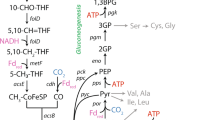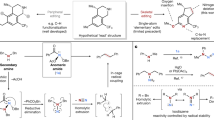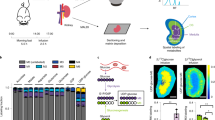Abstract
IN two instances, the distribution of isotopic carbon in the product of a metabolic process has been used to infer that a symmetrical intermediate compound is not involved. Wood et al.1 showed that isotopic carbon, introduced as carbon dioxide together with pyruvate, led to the formation of ketoglutarate which contained isotopic carbon only in the carboxy group next to the keto group; on these grounds, they excluded citrate as an intermediate. Sbemin2 found that when glycine is formed from serine, containing isotopic nitrogen and isotopic carbon in its carboxy group, the relative abundance of nitrogen-15 and carbon-13 in the glycine was the same as in the serine; he argued that amino-malonic acid is therefore not an intermediate in this process.
This is a preview of subscription content, access via your institution
Access options
Subscribe to this journal
Receive 51 print issues and online access
$199.00 per year
only $3.90 per issue
Buy this article
- Purchase on SpringerLink
- Instant access to full article PDF
Prices may be subject to local taxes which are calculated during checkout
Similar content being viewed by others
References
Wood, Werkman, Hemingway, and Nier, J. Biol. Chem., 139, 483 (1941)
Shemin, J. Biol. Chem., 162, 297 (1946)
Author information
Authors and Affiliations
Rights and permissions
About this article
Cite this article
OGSTON, A. Interpretation of Experiments on Metabolic processes, using Isotopic Tracer Elements. Nature 162, 963 (1948). https://doi.org/10.1038/162963b0
Issue date:
DOI: https://doi.org/10.1038/162963b0
This article is cited by
-
N-Heterocyclic carbene-catalyzed enantioselective (dynamic) kinetic resolutions and desymmetrizations
Science China Chemistry (2024)
-
Breakdown of chiral recognition of amino acids in reduced dimensions
Scientific Reports (2020)
-
Immobilization of 6-O-α-maltosyl-β-cyclodextrin on the surface of black phosphorus nanosheets for selective chiral recognition of tyrosine enantiomers
Microchimica Acta (2020)
-
Application of chiral materials in electrochemical sensors
Microchimica Acta (2020)
-
Advances in chiral nanozymes: a review
Microchimica Acta (2019)



